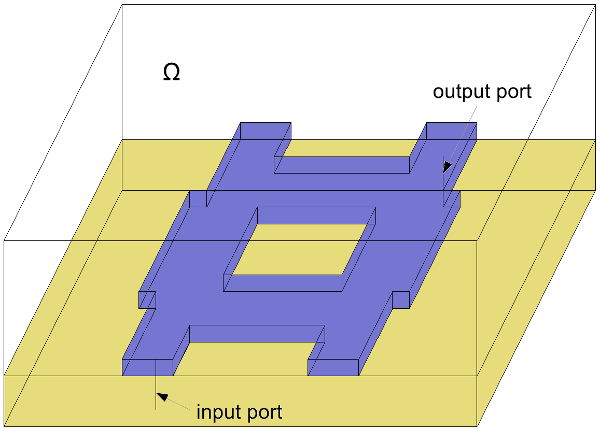m |
(references with cite, figure with crossref, reference link, abbreviation links) |
||
| Line 10: | Line 10: | ||
==Description== |
==Description== |
||
| − | A branchline coupler is a microwave semiconductor device, which is simulated by the time-harmonic Maxwell's equation. |
+ | A branchline coupler (see <xr id="fig:branch"/>) is a microwave semiconductor device, which is simulated by the time-harmonic Maxwell's equation. |
A 2-section branchline coupler consists of four strip line ports, coupled to each other by two transversal bridges. |
A 2-section branchline coupler consists of four strip line ports, coupled to each other by two transversal bridges. |
||
| − | The energy excited at one port is coupled almost in equal shares to the two opposite ports, when considered as a MIMO-system. |
+ | The energy excited at one port is coupled almost in equal shares to the two opposite ports, when considered as a [[List_of_abbreviations#MIMO|MIMO]]-system. |
| − | Here, only the SISO case is considered. |
+ | Here, only the [[List_of_abbreviations#SISO|SISO]] case is considered. |
The branchline coupler with 0.05 mm thickness is placed on a substrate with 0.749 mm thickness and relative permittivity |
The branchline coupler with 0.05 mm thickness is placed on a substrate with 0.749 mm thickness and relative permittivity |
||
<math> \epsilon_r = 2.2 </math> and zero-conductivity <math> \sigma = 0 S/m </math>. |
<math> \epsilon_r = 2.2 </math> and zero-conductivity <math> \sigma = 0 S/m </math>. |
||
| Line 22: | Line 22: | ||
read as the output. |
read as the output. |
||
| + | <figure id="fig:branch"> |
||
| − | [[File:BranchlineCoupler.png]] |
||
| + | [[File:BranchlineCoupler.png|frame|<caption>Branchline Coupler Model<ref>M. W. Hess, P. Benner, "<span class="plainlinks">[http://www.mpi-magdeburg.mpg.de/preprints/2012/MPIMD12-17.pdf Fast Evaluation of Time-Harmonic Maxwell's Equations Using the Reduced Basis Method]</span>", MPI preprint, 2012.</ref></caption>]] |
||
| + | </figure> |
||
| − | == |
+ | ==Data== |
| Line 51: | Line 53: | ||
==Origin== |
==Origin== |
||
| − | The models have been developed within the MoreSim4Nano project. |
+ | The models have been developed within the MoreSim4Nano project<ref>http://www.moresim4nano.org</ref>. |
==References== |
==References== |
||
| + | <references/> |
||
| − | [1] http://www.moresim4nano.org |
||
| − | |||
| − | [2] M. W. Hess, P. Benner, Fast Evaluation of Time-Harmonic Maxwell's Equations Using the Reduced Basis Method, MPI preprint |
||
| − | http://www.mpi-magdeburg.mpg.de/preprints/2012/MPIMD12-17.pdf |
||
| − | |||
==Contact== |
==Contact== |
||
Revision as of 08:55, 5 April 2013
Description
A branchline coupler (see xx--CrossReference--dft--fig:branch--xx) is a microwave semiconductor device, which is simulated by the time-harmonic Maxwell's equation.
A 2-section branchline coupler consists of four strip line ports, coupled to each other by two transversal bridges.
The energy excited at one port is coupled almost in equal shares to the two opposite ports, when considered as a MIMO-system.
Here, only the SISO case is considered.
The branchline coupler with 0.05 mm thickness is placed on a substrate with 0.749 mm thickness and relative permittivity
 and zero-conductivity
and zero-conductivity  .
The simulation domain is confined to a
.
The simulation domain is confined to a  box.
The metallic ground plane of the device is represented by the electric boundary condition. The magnetic boundary
condition is considered for the other sides of the structures. The discrete input port with source impedance 50 ohm
imposes 1 A current as the input. The voltage along the coupled port at the end of the other side of the coupler is
read as the output.
box.
The metallic ground plane of the device is represented by the electric boundary condition. The magnetic boundary
condition is considered for the other sides of the structures. The discrete input port with source impedance 50 ohm
imposes 1 A current as the input. The voltage along the coupled port at the end of the other side of the coupler is
read as the output.

Data
Considered parameters are the frequency  and the relative permeability
and the relative permeability  .
.
The affine form  can be established using
can be established using  affine terms.
affine terms.
The discretized bilinear form is  , with matrices
, with matrices  .
.
The matrices corresponding to the bilinear forms  as well as the input and output forms and the H(curl) inner product matrix have been assembled
using the Finite Element Method, resulting in 27'679 degrees of freedom, after removal of boundary conditions. The files are numbered according to their
appearance in the summation.
as well as the input and output forms and the H(curl) inner product matrix have been assembled
using the Finite Element Method, resulting in 27'679 degrees of freedom, after removal of boundary conditions. The files are numbered according to their
appearance in the summation.
The coefficient functions are given by


The parameter domain of interest is ![\omega \in [1.0, 10.0] * 10^9](/morwiki/images/math/0/1/b/01b72b946d45c569c75d80ba58b182a5.png) Hz, where the factor of
Hz, where the factor of  has already been taken into account
while assembling the matrices, while the material variation occurs between
has already been taken into account
while assembling the matrices, while the material variation occurs between ![\mu_r \in [0.5, 2.0]](/morwiki/images/math/2/9/2/29202560b62a3e37f907f997d40d342e.png) . The input functional also has a factor of
. The input functional also has a factor of  .
.
Origin
The models have been developed within the MoreSim4Nano project[2].
References
- ↑ M. W. Hess, P. Benner, "Fast Evaluation of Time-Harmonic Maxwell's Equations Using the Reduced Basis Method", MPI preprint, 2012.
- ↑ http://www.moresim4nano.org
